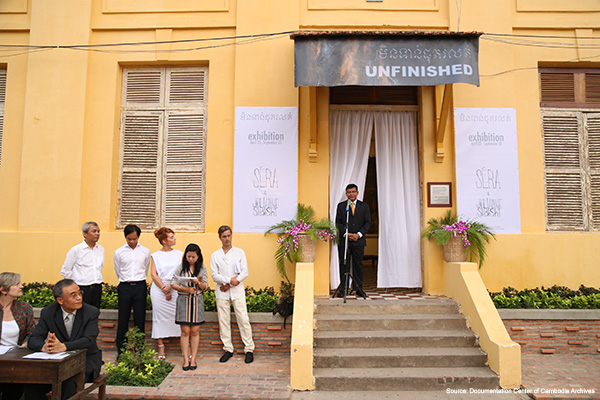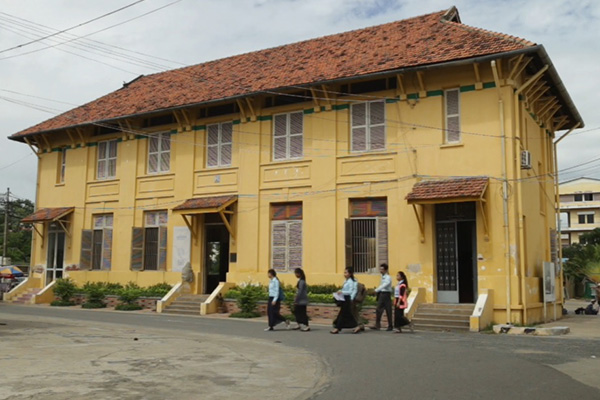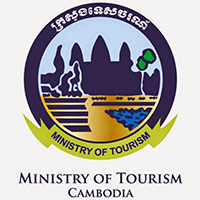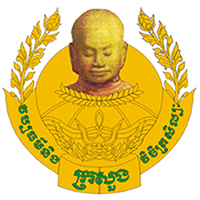|
|
|||||||
| PUBLIC SPEAKER SERIES AT THE SLEUK RITH CONTEMPORARY ART GALLERY | |||||||
|
The Sleuk Rith Contemporary Art Gallery of the Documentation Center of
Cambodia (DC-Cam), housed inside the National Institute of Education, aims
to encourage learning about the history and legacy of the Khmer Rouge and
Cambodia’s arts and culture through temporary exhibitions, weekly
documentary film screenings, and a public speaker series. Additionally, it
contributes to the promotion and support of Cambodian artists by providing
free space inside this century-old colonial building in which to exhibit
their artwork. The main audience for this gallery consists of pre-service
high school teachers, who have traveled from every part of Cambodia to Phnom
Penh, the country’s capital, to receive pedagogical training, students of
Aknuwat High School, and the general public. The Khmer Rouge regime, in power in Cambodia from 1975 to 1979, separated family members from one another and banned schools, the use of money, religious and other cultural practices, and even individual expression of any kind. Almost the entire population was forced to labor in the countryside as farmers or constructing dams and canals. Ultimately, approximately 1.7 million Cambodians died from overwork, starvation, disease or execution, and the country’s social structure, infrastructure and identity were completely shattered. When the Khmer Rouge regime collapsed in 1979, Cambodians were faced with the monumental task of rebuilding their country. After more than three decades of restoration and rejuvenation, there is much to celebrate, while much remains to be done. The devastation was enormous, as traditional cultural knowledge held by those who perished disappeared with them, and as family and community ties were upended. Cambodia continues, to this day, to strive to recover and to move forward constructively. The Sleuk Rith Contemporary Art Gallery of the Documentation Center of Cambodia contributes to this process by embracing both Cambodia’s cultural heritage and artistic innovation as sources of healing and reconciliation, linking the past, present and future in recognition of the art’ power to soothe, educate and inspire. |
|||||||
 |
|||||||
| Minister of Education H.E. Dr. Hang Chuon Naron gives a speech during the inauguration of Sleuk Rith Institute (SRI) Comtempory Art Gallery. SRI is in Collaboration with National Institute for Education (NIE) of the Ministry of Youth & Sports. Photo by Ouch Makara. Source: Documentation Center of Cambodia Archives. | |||||||
| PUBLIC SPEAKER SERIES | |||||||
|
n |
1st Speaker Series: The Use of Khmer language writing, speaking and translating by Dr. Chuor Keary | ||||||
| n | 2nd Speaker Series: Moveable Cultural Property by Prof. Seng Soth | Photo | ||||||
|
n |
3rd SpeakerSeries: A Brief History of Cambodia-Thailand Relations since the 1900s by Dr. Deth Sok Udom | ||||||
|
n |
4th Speaker Series: Stonecutting Worksites during Ancient Times by Prof. Thuy Chanthourn | ||||||
|
n |
5th Speaker Series: Results of New Research at La-ang Spean Prehistoric Site by Heng Sophady | Photo | ||||||
|
n |
6th SpeakerSeries: The Tragedy of Two Cold War Induced Massacres Cambodia and Indonesia by Dr. Benny Widyono | ||||||
|
n |
7th Speaker Series: Holocaust Memory & Genocide Education in Poland History, Memorialization, Reconciliation by Dara Bramson | ||||||
|
n |
8th Speaker Series: From the United States to Democratic Kampuchea Returning to the Homeland by Cindy Coleman | ||||||
| n | 9th Speaker Series: In Speaking in Two Tongues by Dr. Sok Soth | Photo | ||||||
|
n |
10th Speaker Series: Innovations in Health System Development in 12th Century Cambodia under King Jayavarman VII by Oliver Schell | Photo | ||||||
|
n |
11th Speaker Series: Indonesian killings of 1965-1966 by Fildza Nabila Avianti | ||||||
|
n |
12th Speaker Series: The migration-human capital nexus by Sok Serey, PhD | Photo | ||||||
|
n |
13th Speaker Series: Trying to understand the KR thinking and where it went wrong by Gunnar Bergstrom | Photo | ||||||
|
n |
14th Speaker Series: Why did Western Progressives fail to recognise the nature of the Pol Pot regime by Prof. Milton Osborne | Photo | ||||||
|
n |
15th Speaker Series: Turbulent Modern History on Stage and in Song by Toni Shapiro-Phim, PhD | Photo | ||||||
|
n |
16th Speaker Series: Shared Sovereignty in Peacebuilding Processes by John Ciorciari, PhD: English | Khmer | Photo | ||||||
|
n |
17th Speaker Series: Documentation, memorialisation and other reparation legacies of the Extraordinary Chambers in the Courts of Cambodia By Rachel Hughes, PhD: English | Khmer | ||||||
|
n |
18th Speaker Series: Applying Non Violence Communication (NVC) as a Conflict Mediation Tool for Street Educators in Manila the Philippines By Chanchhaya Chhom: English | ||||||
|
n |
19th Speaker Series: Teaching the Holocaust in contemporary Germany: Challenges of dealing with the past 70 years on By Anne Hennings: English | Khmer | ||||||
|
n |
20th Speaker Series: Prosecuting and Remedying Destruction of Cultural Property in the Aftermath of Conflict By by Luke Moffett, PhD: English | Khmer | Photo | ||||||
| CLASSROOM AT TUOL SLENG GENOCIDE MUSEUM | |||||||
|
n |
Program | ||||||
| PHOTO GALLERY | |||||||
|
Contact:
Seang Chenda Curator SRI Contemporary Art Gallery Map: Location for Public Speaker Series |
|||||||

 |
|||||||
| (Yellow building) SRI Contemporary Art Gallery and Khmer Rouge Secret Prison S-21 (now Tuol Sleng Genocide Museum) Source: Dinh Fong/Documentation Center of Cambodia Archives. | |||||||
|
|||||||


